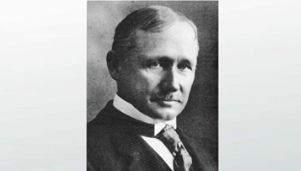Fredrick Taylor & Management: Maximizing Productivity & Efficiency
After you watch the video and know the material, click HERE for the quiz.
Known as the father of scientific management, Frederick Taylor revolutionized management practices. This lesson will discuss the contributions Taylor made to the field of management, most of which are still used today to maximize productivity and efficiency.
What Would Taylor Do?
Ask yourself this question: would you be motivated to work harder for your employer if you were not given the proper training or tools to do your job and you were paid the same amount regardless of the level of effort you put forth? I assume most of you answered 'no' to this question, and Frederick Taylor agreed!
 |
The Observations of Frederick Taylor
As a young engineer working for Midvale Steel Company in the late 1800s, Frederick Taylor began to recognize the shortcomings of systematic management practices. He observed how the gross, almost deliberate, inefficiencies of workers led to low levels of productivity. As Taylor investigated further, he discovered that employees were underpaid, their potential was unused, and there was a great deal of waste and inefficiency of workers and work processes. He attributed these issues to three things:
- First, employees believed that if they were more productive, fewer jobs would be needed, and thus their job might be in jeopardy.
- Second, employees did not have an incentive to go above and beyond; if they were paid the same amount for low productivity as they would be for high productivity, there was no reason for them to strive for higher levels.
- Third, workers wasted much of their time using less-than-optimal methods for completing work instead of the best possible way.
 |
Taylor soon realized that these unsystematic decisions being made by management were without empirical evidence or research that demonstrated a significant rationale for what the best means of production were. Essentially, managers were blindly making decisions on how to lead their workers, almost like the blind leading the blind.
The Father of Scientific Management
Taylor's solution was to create a second approach to management that accounted for all those issues he was seeing at Midvale Steel Company. What is now known as scientific management, this new approach advocated the use of scientific methods to scrutinize individualized tasks of production work to find the most effective method. The specifics of scientific management are detailed in another lesson of this course, but to help you understand how Taylor arrived at this new approach, we will discuss the steps he took to get there.
Using his engineering background, Taylor studied tasks and incentives to develop fixed procedures to maximize productivity and efficiency. He used time and motion studies to determine how long it should take a person to complete a task when the correct movements were made. He also looked for ways to standardize tools so that each worker had the right tool for the job. Finally, he believed that an employee's effort towards reaching higher levels of productivity should be directly tied to their pay. For example, Taylor studied workers at the Bethlehem Steel plant who were responsible for unloading iron from rail cars. He found that when the correct tools, movements, and procedures were used by workers, they could average 47.5 tons per day instead of the typical 12.5 tons per day. This only required 140 workers to complete the work each day as opposed to the usual 500. Once the work process was clearly defined according to the best possible way, he added an incentive system that would compensate those employees who were able to meet the new standard set by Taylor. The result of this change was unsurpassed as the productivity at the Bethlehem Steel plant drastically increased overnight.
 |
Taylor's Four Principles of Scientific Management
Frederick Taylor conducted many experiments over the duration of his career and had several associates, which you can learn about in other lessons of this course. After his work was completed, he was then able to, finally, provide managers with a set of systematic guiding principles so that they no longer had to make uninformed decisions. Taylor's approach to management can be summed up into his four principles of scientific management.
- Management should get rid of general guidelines for how to complete a task; instead, they should be replaced with a precise, scientific approach for each task of a worker's job.
- Management should use those same principles of scientific methodology to carefully recruit, select, train, and develop each worker according to the job they will hold for the company.
- There should be a level of cooperation between staff and management to be sure that jobs match plans and principle of the developed methods.
- Managers should also provide the appropriate division of labor and responsibility between managers and workers; that is, the managers were responsible for planning the work, and the employees were responsible for following that plan as they completed the work.
The Four Principles Applied
A simple example of Taylor's principles in action is shown in the following story. Bob the Bricklayer was hired by Berry Miller to build a block fence in his yard to keep his neighbor from spying on his wife while she sunbathes. Bob knows that he must plan out this job so that he can properly bid the cost of the job to Berry. Bob the Bricklayer spends time detailing out the best method for building the block fence, how long it should take, what the costs should be, and how many laborers he will need to help him build the fence. After his plan is in place, Bob selects two of his finest block fence builders to help him construct the fence. He knows that the two employees he chose are well-trained in block fence building, and he'll only need to provide moderate supervision to them. Bob will oversee his employees and make sure they follow the plan he detailed out at the beginning of the project. The employees have a full understanding of what their role is in the job, and so does Bob. Because the plan was followed as Bob laid out by employees, who are aware of their role in the job and had a good understanding of the work that needed to be completed, the block fence went up without issue. Berry Miller was extremely happy, but his neighbor was extremely disappointed that he would no longer be able to enjoy the view from next door.
 |
Lesson Summary
To review: Frederick Taylor began to recognize the shortcomings of systematic management practices early in his career as an engineer. He found that workers were underdeveloped, underpaid, and under-resourced, and consequently, they did not care to put forth a high level of productivity. As a result, factories were suffering. Taylor's solution was to create a second approach to management known as scientific management. Taylor studied tasks and incentives to develop fixed procedures to maximize productivity and efficiency. After many experiments, Taylor developed a set of management principles that included:
- Management should get rid of general guidelines for how to complete a task; instead, they should be replaced with a precise, scientific approach for each task of a worker's job.
- Management should use those same principles of scientific methodology to carefully recruit, select, train, and develop each worker according to the job they will hold for the company.
- There should be a level of cooperation between staff and management to be sure that jobs match plans and principle of the developed methods.
- Managers should provide the appropriate division of labor and responsibility between managers and workers; that is, the managers were responsible for planning the work and the employees were responsible for following that plan as they completed the work.
Taylor quickly became known as the father of scientific management for having revolutionized management practices, most of which are still being used today.